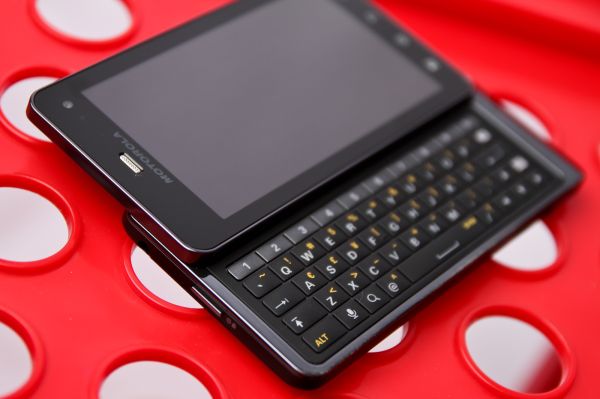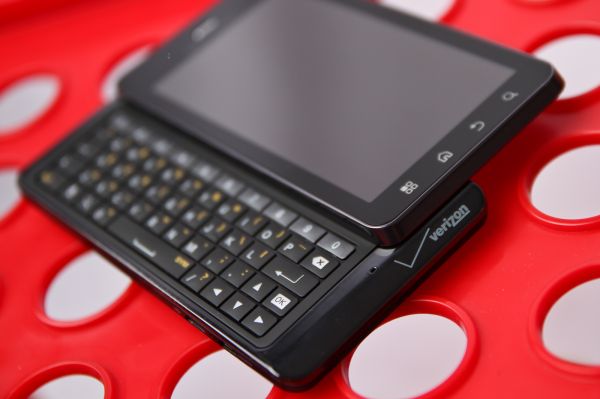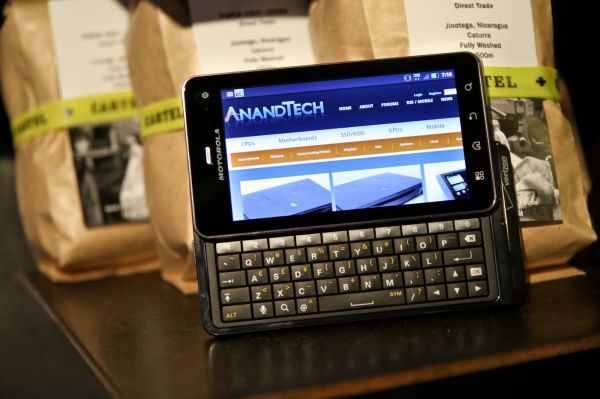Motorola Droid 3 Review - Third Time's a Charm
by Brian Klug on July 30, 2011 12:01 AM ESTConcluding Thoughts
So here we are, one year after the Droid 2, and now we have the Droid 3. Dual core smartphones are now pretty much the norm, and overall smartphone adoption shows little to no signs of slowing down anytime soon. On its own, the Droid 3 is a considerable upgrade over the Droid 2. You get a vastly better keyboard, higher resolution display, better cameras, higher resolution and better quality video recording, much better CPU and GPU performance, a better baseband with GSM/WCDMA compatibility out of the box, and Android 2.3.4. One short year later, the same price buys you a considerably better device in almost every possible category.
The problem is that there’s no LTE onboard, which seems in retrospect like a major tactical error on Motorola’s part until you consider that adding that in would likely dramatically change the Droid 3’s size and battery life. Like it or not, we’re still in the first generation of LTE modems, all of which are 45nm at present. Qualcomm’s LTE MDM9600 baseband, which is at the core of an overwhelming majority of current Verizon Wireless LTE devices, is a 45nm part and not directly voice enabled. Around mid 2012, MDM9615 will begin shipping, bringing 28nm LTE/EVDO/DC-HSPA+ connectivity in a slightly smaller, less power-hungry package, and also bringing onboard voice to bear. Only at that point (or with MSM8960 potentially sooner) and with similar parts does LTE connectivity on the device become something you can include without a complicated dual-baseband solution.
It’s roundabout, but basically what looks at first like a tactical error on Motorola’s part really isn’t - they made a design tradeoff and instead the Droid 3 is one of the thinnest (if not the thinnest) devices with a slide-out keyboard. Instead, if you want LTE and a physical keyboard, you’re going to have to wait a while until Samsung or another partner brings it to bear. That said, Motorola does have some LTE-enabled devices headed to Verizon, which we’ll look at in due time, but they likely won’t include keyboards.
If you’re in a market that Verizon hasn’t included in its official list for deployment by the end of 2011, there’s really no point to owning a first generation LTE smartphone. At that point, current devices like the Droid X2 or Droid 3 make sense, or waiting for devices based on some less power-hungry second generation basebands that will no doubt be the rage around the same time next year.
I like the Droid 3 a lot more than I thought I would going into it, just because of how much importance I personally put on having the fastest cellular connectivity. It’s sort of a running joke among friends and people that know me that I spend far too much time running speed tests, and so I went into this review ready to be underwhelmed by more EVDO slowness. I was definitely wrong about how great this device really turned out to be. Keyboard, display, OMAP4, and overall size culminate to a device that feels like way more than just an updated Droid 2.
The device has had another unintended side-effect as well. The Droid 3’s awesome keyboard has made me wish more of the Android flagship, triple-A devices had physical keyboards. Capacitive multitouch keyboards are great, but something is always going to get lost in the process of making a keyboard virtual. It’s also clear to me that developer focus has shifted away from landscape view, with so many Android applications forcing you into portrait-only mode because there’s so much more attention on portrait than landscape devices with keyboards. Maybe it’s time for a Nexus device with a keyboard to remind developers that landscape still exists.













84 Comments
View All Comments
Lucian Armasu - Sunday, July 31, 2011 - link
I completely agree with you on this. Either raise the resolution for a normal LCD/AMOLED screen (RGB) or don't raise it at all if you're going to use Pentile. It makes the display worse overall.It's like you're trying to increase sharpness of the display by increasing resolution by 30%, and then you use Pentile which *drops* sharpness by 60%. The end result is negative on the sharpness of the display.
YoPete525 - Sunday, July 31, 2011 - link
Have you guys actually looked at the Droid 3 in person? Most elements on the screen still appear sharper than say on the Incredible 2, which has a relatively comparable 4-inch screen with the 800x480 resolution. You also have to realize that a higher resolution means more viewable content, such as more settings options on the same screen, or more emails in the same view. The increased detail is very noticeable on, for example, home screen icons, looking at the Droid 3 and then a phone with the traditional 800x480 makes icons on the smaller resolution screen appear comically large.Solid colors, especially the green (which is in the battery icon), do look fuzzy, as well as a combination of lines on certain backgrounds, and colored text. But at least give the screen a chance in person before you write it off. In terms of overall screen sharpness, you're right in that the RGBW Pentile matrix isn't ideal, but it isn't as bad as you make it out to be.
snowblind64 - Sunday, July 31, 2011 - link
Let's not forget there are benefits to a RGBW pentile screen. Battery drain is consistently well under 10% on my Droid 3 thanks to that extra white sub-pixel.themossie - Sunday, July 31, 2011 - link
For some, it really is that bad.I used it in person, spent a couple off hours in the shop playing with it. Compared to the Droid 1, on the Droid 3 I have to read text at a greater font display size / zoom level (the characters have to be bigger on screen) and as a result can fit less content on the screen than on the Droid 1.
Best comparison I can make: it feels like you are running an LCD screen at a very uncomplimentary non-native resolution. Try running a 1080p screen at 900p, it's painful to most any power user - you can still read and do work, but everything is fuzzy and hurts the eyes. Some people aren't bothered by this, others get headaches.
For UI elements, the screen is acceptable; for reading this becomes a problem.
I'm glad (and jealous) the Droid 3 screen works for you :-) I want a new slider that beats my OG Droid!
RavnosCC - Monday, August 1, 2011 - link
Agreed! I played w/the phone side by side with my D1 on all my favorite sites, reading the same content... trying to find a comparable zoom level on the D3 that didn't make the text look horrible was near impossible on most of the sites I frequent. I think Moto needs to seriously rethink the idea that increasing specs while effectively lowering quality will become the future :( The trade-offs aren't worth it, imho.relativityboy - Thursday, August 4, 2011 - link
As a posessor of the D3 I can say my D1's screen looks much better.Brian Klug - Sunday, July 31, 2011 - link
So you have to keep in mind that the photo actually is a 100% crop that I supplied to just show the differences in the subpixel matrix between RGBW and RGB.I've been pretty critical of PenTile RGBG in the past, and admittedly RGBW still isn't as desirable as straight up RGB, but it definitely is a way to emulate higher equivalent resolution. The other RGBW advantage is of course the reduction in power (just keep the W subpixel in the on position when displaying white) and thus requiring a less powerful backlight.
Again, I'd definitely prefer a true qHD 960x540 display like what HTC has on the Sensation/EVO 3D, but this isn't too bad compared to how RGBG looked on the previous generation of AMOLED displays, if nothing else because the vast majority of webpages render with sharp black edges properly.
-Brian
Lucian Armasu - Sunday, July 31, 2011 - link
It's because of the Pentile Matrix. It makes the screen fuzzier. I wish manufacturers would stop using it. It's not a trade-off I'm willing to make over whatever benefits Pentile brings.hwarrior - Saturday, July 30, 2011 - link
Too bad Droid 3 is Verizon linked.http://www.engadget.com/2011/07/18/motorola-xt860-...
jjj - Saturday, July 30, 2011 - link
Motorola will be using 2 LTE chips in it's 5 LTE devices planned to be released this year (Xoom, Bionic,1 more phone and 2 more tablets).One of the chips is developed by Motorola and the other one ... no clue really but Motorola might not want to kill battery life by using Qualcomm so maybe ST-E or Icera.